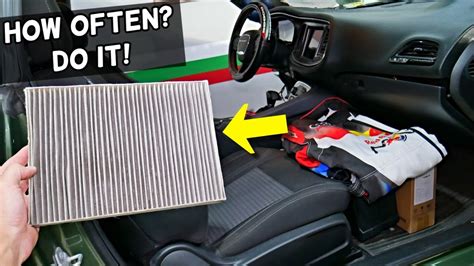How Often Should You Replace Your Cabin Air Filter? A Comprehensive Guide
Keeping your car's cabin clean and air fresh is crucial for a comfortable and healthy driving experience. A significant part of this involves regularly replacing your cabin air filter. But how often should you actually do this? This comprehensive guide will help you determine the optimal replacement schedule for your vehicle.
Understanding Your Cabin Air Filter
Your cabin air filter is a small but mighty component located within your car's ventilation system. Its primary function is to filter out pollutants from the air entering your vehicle's cabin. These pollutants can include:
- Pollen: A major allergen for many drivers and passengers.
- Dust and Dirt: These can accumulate and impact air quality.
- Mold and Mildew: Can cause unpleasant odors and potential health issues.
- Exhaust Fumes: Especially important in heavy traffic areas.
A clogged filter reduces airflow, leading to decreased heating and cooling efficiency, and potentially even causing damage to your car's HVAC system. More importantly, it compromises the air quality you and your passengers breathe.
How Often to Replace Your Cabin Air Filter: The General Rule
The general recommendation is to replace your cabin air filter every 12,000 to 15,000 miles, or once a year, whichever comes first. However, several factors can influence this timeframe.
Factors Affecting Replacement Frequency:
- Driving Conditions: If you frequently drive in dusty, polluted areas, or during high pollen seasons, you'll likely need more frequent replacements.
- Climate: Hot, humid climates can promote mold and mildew growth, necessitating more frequent filter changes.
- Vehicle Usage: High mileage vehicles may require more frequent filter replacements.
- Filter Type: Some filters are designed to last longer than others. Check your owner's manual for specifics.
Signs Your Cabin Air Filter Needs Replacing
Don't wait until your scheduled replacement time if you notice any of these signs:
- Musty or Unpleasant Odors: This is a clear indicator of mold or mildew buildup.
- Reduced Airflow: If your car's air conditioning or heating system isn't blowing as strongly as usual, a clogged filter might be the culprit.
- Increased Allergen Symptoms: Experiencing more sneezing, coughing, or watery eyes while driving suggests a compromised filter.
- Whistling or Rattling Sounds: These noises can indicate a dirty or damaged filter.
How to Replace Your Cabin Air Filter
Replacing your cabin air filter is a relatively simple task that many car owners can perform themselves. Consult your vehicle's owner's manual for specific instructions, as the location and filter type can vary depending on the make and model. Generally, the process involves:
- Locating the cabin air filter: This is usually found under the dashboard or in the engine compartment.
- Removing the old filter: This often involves removing a cover or accessing a compartment.
- Installing the new filter: Ensure you install the new filter with the correct airflow direction (indicated by arrows on the filter itself).
Note: If you are uncomfortable performing this task yourself, consult a professional mechanic.
Choosing the Right Cabin Air Filter
When choosing a replacement filter, opt for a high-quality filter that meets or exceeds the specifications recommended by your vehicle's manufacturer. Consider filters with features like activated carbon to better absorb odors and pollutants.
Conclusion: Prioritize Clean Air
Regular cabin air filter replacement is essential for maintaining a clean and healthy driving environment. By following these guidelines and understanding the signs of a failing filter, you can ensure a consistently comfortable and safe ride for yourself and your passengers. Remember to check your owner's manual for specific recommendations and replacement intervals for your particular vehicle model.
